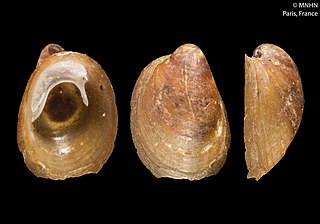
Latia neritoides is a species of small freshwater snail or limpet, an aquatic gastropod mollusc in the family Latiidae.
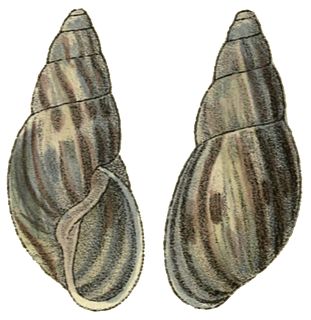
Anthinus henselii is a species of air-breathing land snail, a terrestrial gastropod mollusk in the family Strophocheilidae.

Trimusculus conicus is an air-breathing sea snail or false limpet, a pulmonate gastropod mollusc in the family Trimusculidae, the button snails.
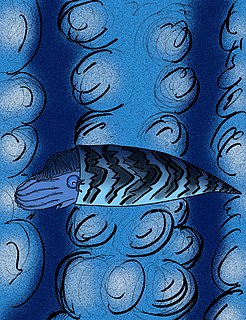
Nanno is an Endocerid, named by Clarke in 1894 for the apical end of an endocerid from the Trenton Limestone of New York state that has the basic description of the nanno type. It is possibly the senior synonym for Proterovaginoceras. As a valid genus, Nanno is included in the Endoceratidae but the nanno type apex may be found in other families.

Vertigo milium, common name the blade vertigo, is a species of minute air-breathing land snail, a terrestrial pulmonate gastropod mollusk in the family Vertiginidae, the whorl snails.

Bellerophontoidea, common name "bellerophonts", is a superfamily of extinct planospirally-coiled globose molluscs. This superfamily is generally included within the Gastropoda, but may instead be a group of monoplacophorans. The taxon first appeared late in the Cambrian and continued until late in the Triassic.

Cucumerunio websteri is a species of freshwater mussel, an aquatic bivalve mollusc in the family Hyriidae.

Seashore wildlife habitats exist from the Tropics to the Arctic and Antarctic. Seashores and beaches provide varied habitats in different parts of the world, and even within the same beach. Phytoplankton is at the bottom of some food chains, while zooplankton and other organisms eat phytoplankton. Kelp is also autotrophic and at the bottom of many food chains. Coastal areas are stressed through rapid changes, for example due to tides.
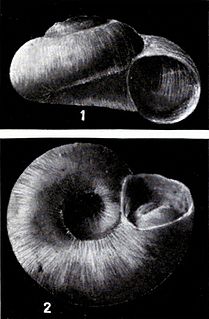
Valvata oregonensis is a species of fossil freshwater snail with a gill and an operculum, an aquatic gastropod mollusk in the family Valvatidae, the valve snails.
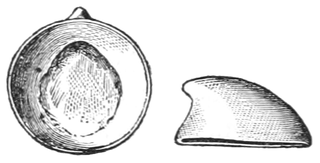
†Archinacellidae is an extinct family of paleozoic molluscs of uncertain position.
Bucaniidae is an extinct family of Paleozoic molluscs of uncertain position possibly being either gastropods or monoplacophorans in the superfamily Bellerophontoidea. The family lived from the Lower Ordovician to the Devonian and have shells in which the apertural margins tend to flare. Most genera have a slit and selenizone, others some modification of this feature.

Pilina unguis is an extinct species of Paleozoic Silurian monoplacophoran. It was first named as Tryblidium unguis and described by Gustaf Lindström in Latin from the Silurian deposits of Gotland in Sweden, in 1880.

Helcionopsis radiatum is an extinct species of paleozoic monoplacophoran in the family Tryblidiidae.

Helcionopsis is an extinct genus of paleozoic monoplacophoran in the family Tryblidiidae.
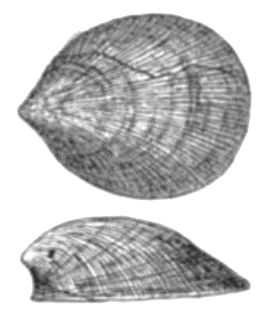
Helcionopsis striata is an extinct species of paleozoic monoplacophoran in the family Tryblidiidae.
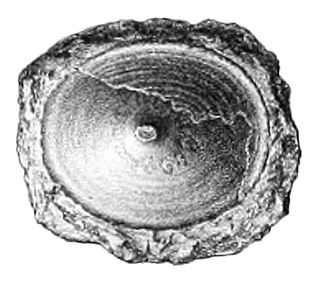
Pilina solarium is an extinct species of a paleozoic Silurian monoplacophoran. It was first named as Palaeacmaea solarium and described by Gustaf Lindström from Silurian of Gotland in Sweden in 1884.
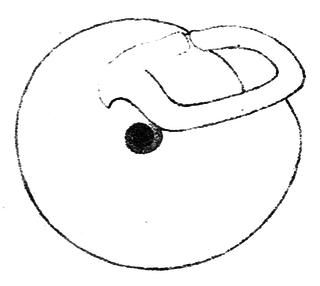
Hyperaulax ridleyi is a species of tropical air-breathing land snail, a terrestrial pulmonate gastropod mollusk in the family Odontostomidae.
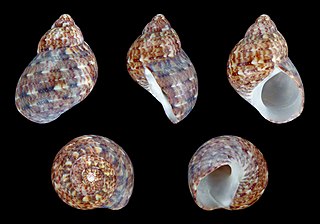
Phasianella solida, common name the solid pheasant, is a species of sea snail, a marine gastropod mollusk in the family Phasianellidae.

Broderipia subiridescens is a species of sea snail, a marine gastropod mollusk in the family Trochidae, the top snails.
Phragmolites is an extinct genus of molluscs in the family Bucaniidae, paleozoic molluscs of uncertain position possibly being either Gastropods or Monoplacophorans in the superfamily Bellerophontoidea.
















